October/November 2018
Desert Adapted?
We work on adjusting the Tiger, the plan and ourselves to life in the desert
Namibia is mostly desert. Lots of things just don’t survive out here. They need cooler weather, or trees, or more water, or at least the occasional cold beer. Beetles do well, and snakes and lizards; and others who shall remain un-named for fear of calling them closer. Native Californians? We’ll have to see about them.
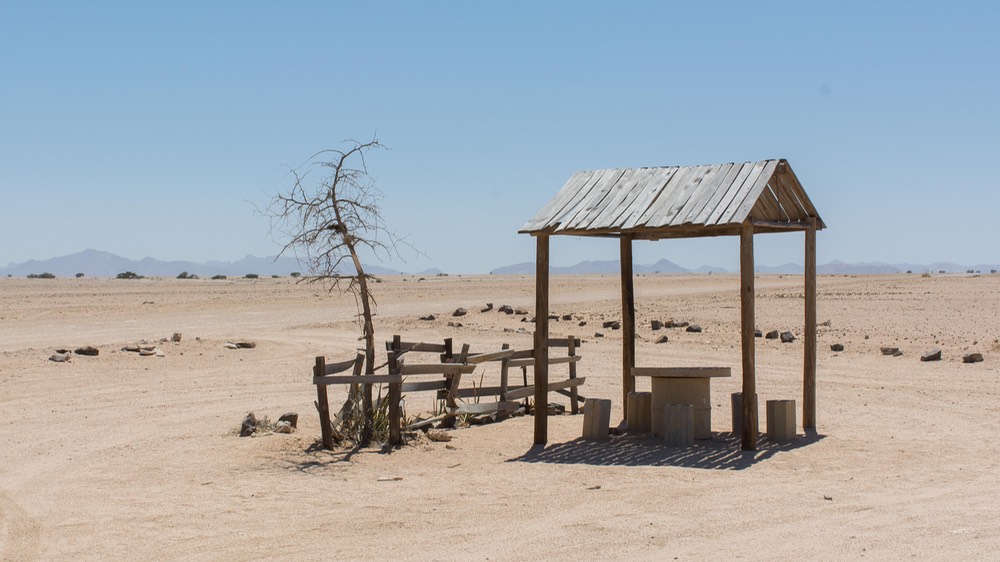
There are also critters who seem to manage well enough. We are seeing oryx regularly, along with springbok, ostrich, and the occasional zebra. We’ve even seen giraffes out here. The scientific crowd call these guys “desert-adapted.” We now include ourselves in that group, well marginally, or at least we’re working on it.
How do you know you’re wandering in the desert? Your bananas have a shelf-life of 2 days. Your dishes dry themselves in less than 10 minutes. The bread never gets moldy, even if the only thing it’s good for is French toast. Your skin is, well, something less than gentile. I knew I should have brought those white gloves. At 9:00 am you wish you’d already taken that lovely walk you promised yourself last night — it was too hot to go then, and it’s already too hot now. And damn! you should have made more ice before the water reserve got so low.
On the other hand, the deserts of Namibia are lovely. If you’re like us, when you think of desert, Death Valley or Mojave are probably what pop into your head. Well, re-think. It’s beautiful here. Long sweeps of nothing with dramatic rock outcroppings, inselbergs, popping up in the distance. Low depressions with trees (usually camelthorn) in a line, telling you that after the very, very occasional rain there will be water in that riverbed. Quiet colors in the rocks that spring into bright drama when the sun sets. And then, as darkness settles in, that incredible canopy of stars above you that is just everywhere.
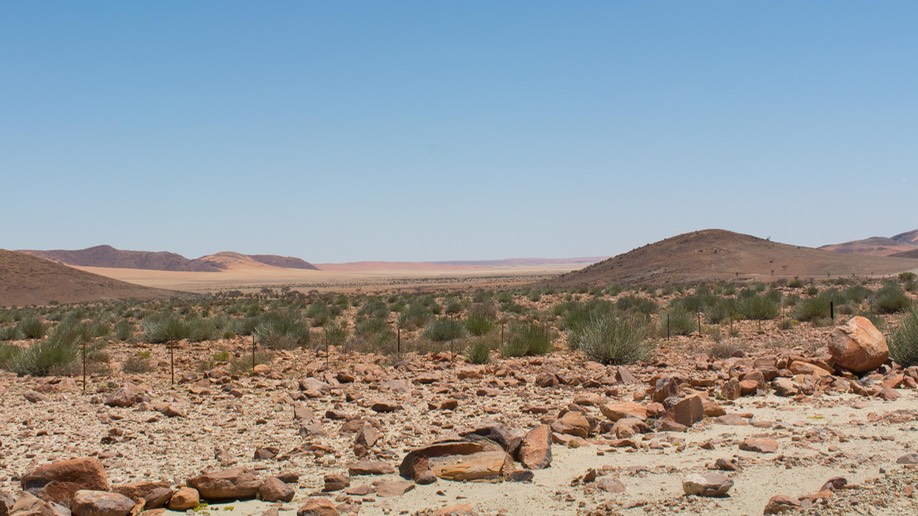
We’ve been wandering out here in the (semi) sands for most of the last month or so. Some of the roads are even paved, but it’s hard to remember when last you saw them. It’s a rough go a lot of the time, and we’re taking it slowly, so we don’t cover a lot of ground per day. We let the faster vehicles pass us by; regardless of how well our Chevy truck is built, La Tortuga carries its house on its back, and that house is filled with pots and pans and other at-risk items. So Rick goes gently into that rough gravel area. The days can be long, but the rewards are many. And you should never forget that profound adage: “the gravel is always smoother on the other side of the road.” Also you must remember that adages are often wrong.
So in case you were concerned, we really must tell you — we are having a very good time. Lots of difficulties and complications, and some significant heat (to us wimps, anyway). But really interesting and dramatic scenery, campsites other countries should envy, beautiful people to meet, and cool critters. So worry not; all is well.
On the day before our South Africa visas were to expire, we fled across the border into Namibia (shades of WWII espionage novels). We had just spent a couple of days at a campground outside of Springbok, a town about 100 kms further south on the SA side. Springbok is often used as a staging area for overlanders either going north into the Namibian countryside, or returning south down into the relative comforts of South Africa. There is good shopping in Springbok, and the campsite is a great place to regroup before plunging ahead. It even has a swimming pool.
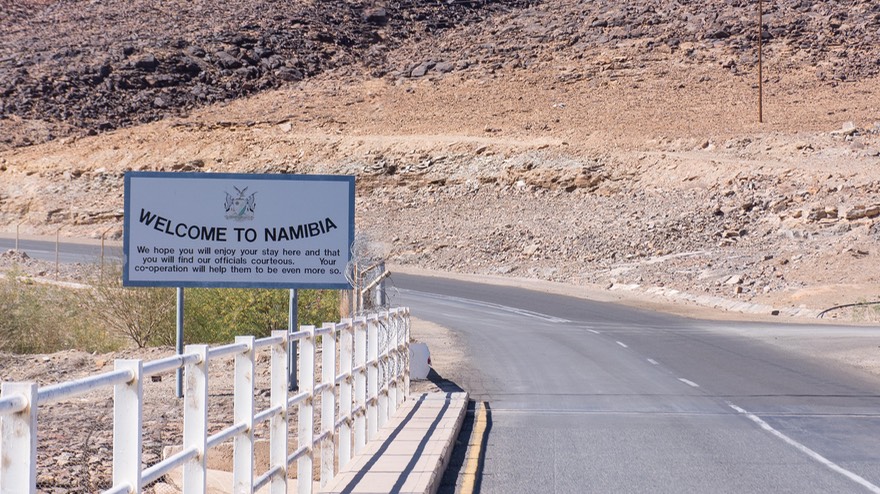
As we were organizing our plans for the Namibian Adventure, we discovered that parked right next door to us was a terrific resource. André and Ann are seasoned travelers in the areas we want to visit, and in fact had just left Namibia heading back home to Cape Town. They were quite happy to spend some time with us, poring over maps and digging up information on where to stay, where you would want to take extra water and supplies, what roads might be too much for us, places not to miss; stuff like that. They were just great; along with their buddies Graham and Denise, who are visiting from Scotland, we had great chats. When we parted company, we felt much better prepared for the coming three months.
Crossing the border from SA was easy and non-stressful. Nobody cared about our bloody carnet, either leaving SA or entering Namibia, which might prove to be an issue later on. But at each stop they were cheerful, helpful, and waved us on our way. The crossing was right at the Orange River, which marks much of the southern border, and we soon found a pretty campground where we could stay for a couple of days, enjoying the lovely river setting and all the birds, and watching folks in kayaks and canoes floating about. It was windy and hot.
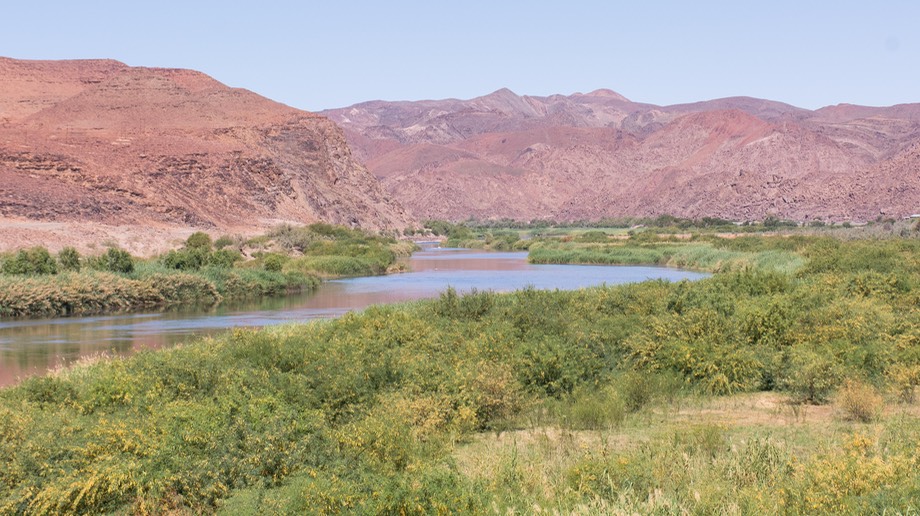
The Orange River is a splendid, large body of water that cuts along the southern edge of the country before emptying into the Atlantic Ocean. It is the major source of water for this part of Namibia, and allows for large farming operations to be successful; we saw lots of vineyards as we drove along. Right along the river it is lush and green; about a kilometer away you are in dry, dry desert. The difference is quite marked. The river was placid during our visit, but we saw pictures of massive flooding that had taken place in 2011 — the entire site was under water, right up to the reception area, which is about five meters higher than the current level of the river. Startling!
But — time to move on. We left the river on beyond the tiny community of Aussenkehr, and then back into the desert. The humidity had now dropped to 2%, where it will, we suspect, remain for most of our time here. Hand lotion is our friend.
We headed towards Fish River Canyon, claimed to be the second largest canyon in the world. We’ve been told this is a must-see spot “even though it’s not as dramatic as the Grand Canyon.” Well, you know what? It’s a great place, and should not be missed. (Kathy, at least, thinks the Grand Canyon is a bit over-rated, while Rick disagrees.)
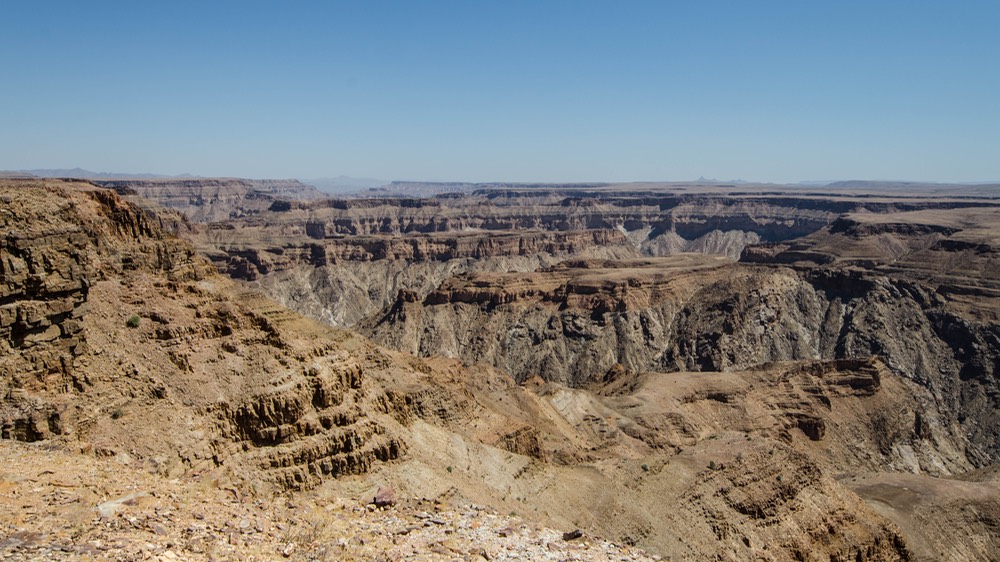
We enjoyed ourselves, staying in the park campground overnight. It was windy and dusty, increasingly so as the evening wore on. We would have liked to have kept all the windows open, to take best advantage of the breeze; but there were baboons on site, and they will just tear a screen apart if they think they can get inside and go after something interesting. So we closed windows and kept fans running all night. It stayed pretty hot… at 3:30 am it was still 84℉.
We suggest an early morning visit to the canyon is best; the light is good, the colors are stronger, and it’s cooler. The Fish is sometimes a pretty big river; geologically, in times past it cut a really deep canyon. The main viewpoints for the canyon are on the east rim, so the light in the afternoons is less advantageous.
Ready to move on to new adventures, we headed back out onto the road, aiming for Keetmanshoop. Along the way, we saw a Black-Backed Jackel flitting past us on the road. We wished he’d lingered for a bit so we could get a better look, but we were happy with plenty of springbok and ostrich sightings.
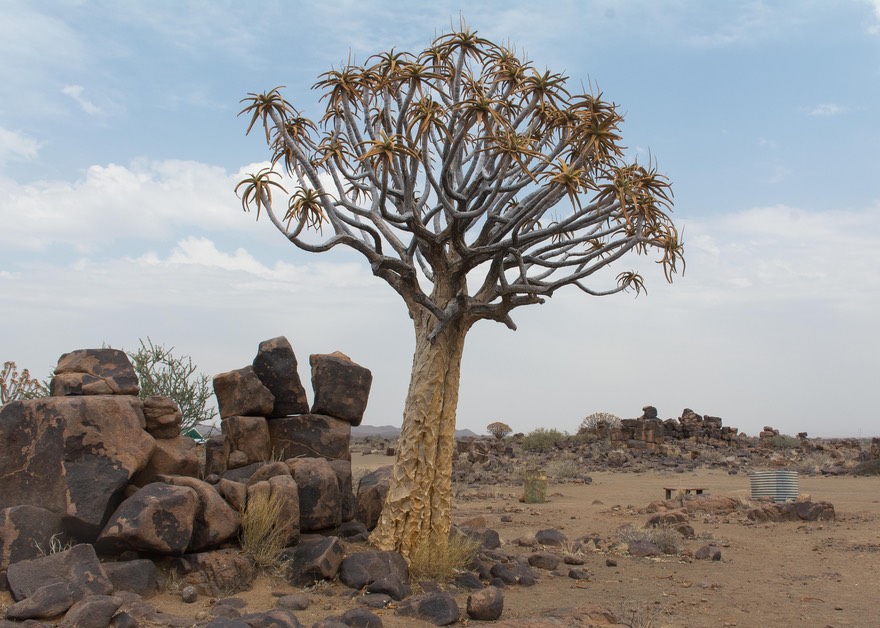
We were delighted to get to Keetmanshoop. There was some shopping to be had — both a Shoprite and a Spar were listed. Well, not quite. We found the Shoprite easily, in the town’s small outdoor mall area. But no Spar, although the advertising banners were well displayed. So we asked a fuel station fellow. “We lost our Spar a couple of months ago” was the answer. We hope they get it back; we like this small regional hub. Rick was able to do business with the MTC folks, and so now we have wifi back again. I tried to get some information on upcoming sites from the tourist office, but that didn’t work so well; that’s okay — things seem to sort themselves out all right regardless.
A short distance north of Keetmanshoop we found Garas’ Quiver Tree Park, where we spent the night. This place was truly delightful. Funky? Casual? For sure. Reminded me of the Arizona desert. There were all kinds of things made out of old auto parts or bicycles or thisses and thats. Flower pots from oil cans. Assemblages, I guess you would say. We had a fun night up at Garas’ Park; whimsy meets recycling.
And quiver trees to enjoy. Quiver (kokerboom in Afrikaans) trees are big in parts of Namibia. They are kind of weird, and look like they could be related to baobabs, although they are much smaller. Very fat trunks, and then skinny limbs that stick out above and have succulent leaves coming out; they are members of the aloe family. They are called quiver trees because tribes used to make quivers out of hollowed out portions of the trunks, and put their poison-tipped arrows in them. You remember the pigmies in the Amazon and their poison-tipped arrows? Same deal.
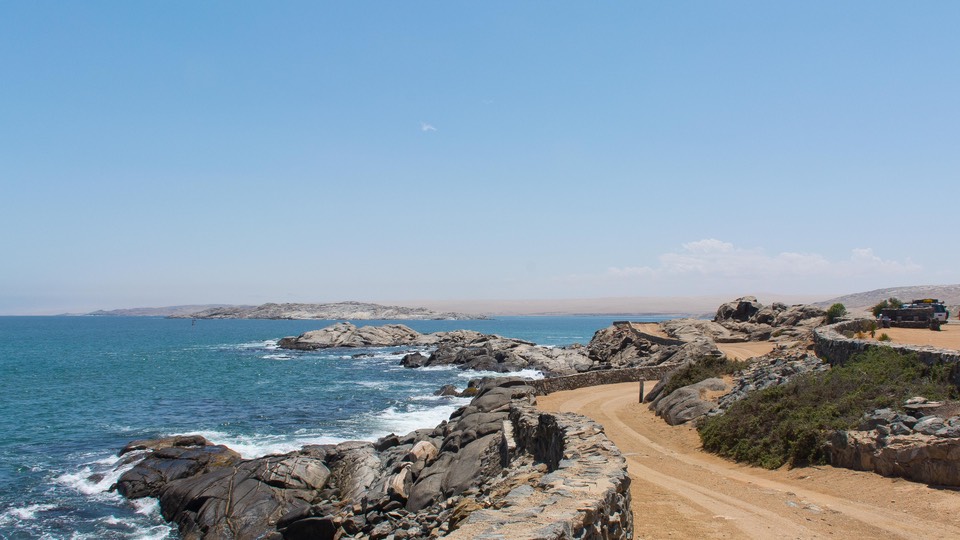
It rained during the night, cooling the air. The next morning was clear and quite pleasant as we started west toward the coast. Then it all dried out, warmed up (81℉), and then rain/dust/sleet and down to 67℉ . Then back up to 91℉ — all within 10 minutes. Since we were heading to where we knew it should be cool, we weren’t too concerned. On arrival in Lüderitz it was lovely, clear and very pretty.
Lüderitz is an old diamond-mining town and port. We stayed at a campsite right on a point, called Shark Island; it used to be the location of a (very nasty) prison, but these days is a casual campground with the sites set among the rocks. Not a lot going on, but we enjoyed staying there for a few days. We had come to the coast to get cooled down, and it worked.
This is an old, old German town, and the buildings reflect it. It’s also a nice clean town despite being a large port. There is much fresh paint on the buildings and the whole town looks ready for company.
Lüderitz is a very popular place and we could see why. We did some shopping, wandered the town, and did a lot of relaxing. I suspect we may return as Namibia has only about three decent-sized towns along the entire coast — and the coast is your only option for getting cooled off, so each of them gets lots of attention from travelers. We’ll see how our time works out.
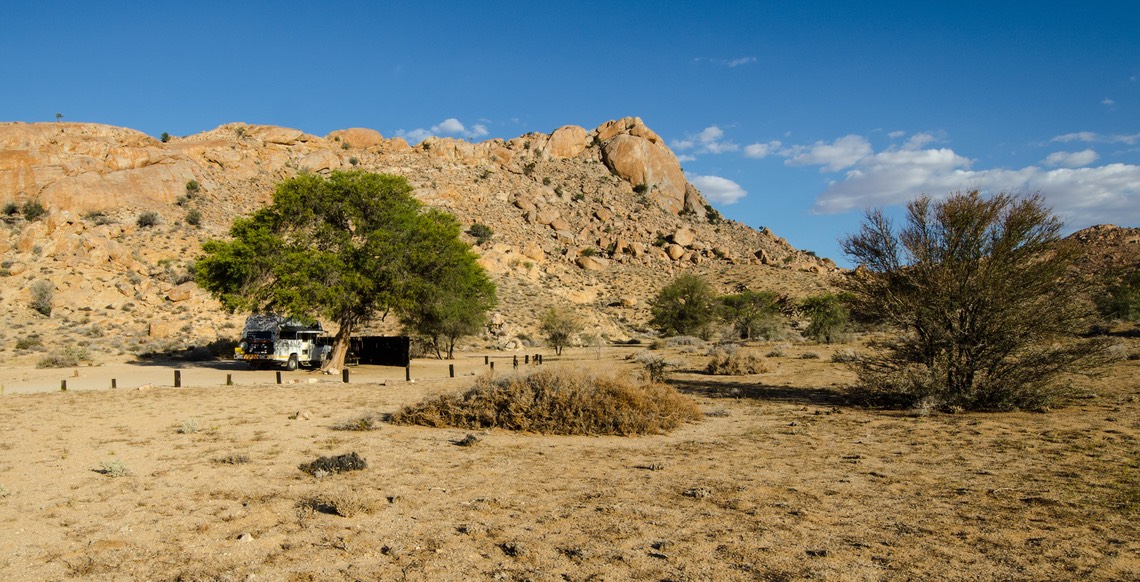
We could have stayed here longer, but the weather report (surprisingly) said it was going to get pretty hot here on the coast, at sea level. Looking ahead, the town of Aus, up about 1000 meters onto the western edge of the Escarpment, would be a better choice for the next few days, so off we went.
We should take a minute and briefly talk about the geography of Namibia. In a general sense, the country is pretty rectangular, running north-south. The lower 3/4 starts with a narrow coastline, followed by desert (the Namib); then, moving east, you climb up to the Great Escarpment, which sits at about 1000 meters and covers much of the area travelers move through. Continuing toward the eastern edges the escarpment slowly loses elevation, settling down into the Kalahari Desert, which is shared with Botswana. That’s about it — except that the northern section of the country drops to lower elevation (and is both hotter and wetter) and contains Etosha NP in the western area and then the Caprivi Strip (now renamed the Zambezi Area) as it runs across the top of the country. Confused? It starts to sort itself after awhile, we promise.
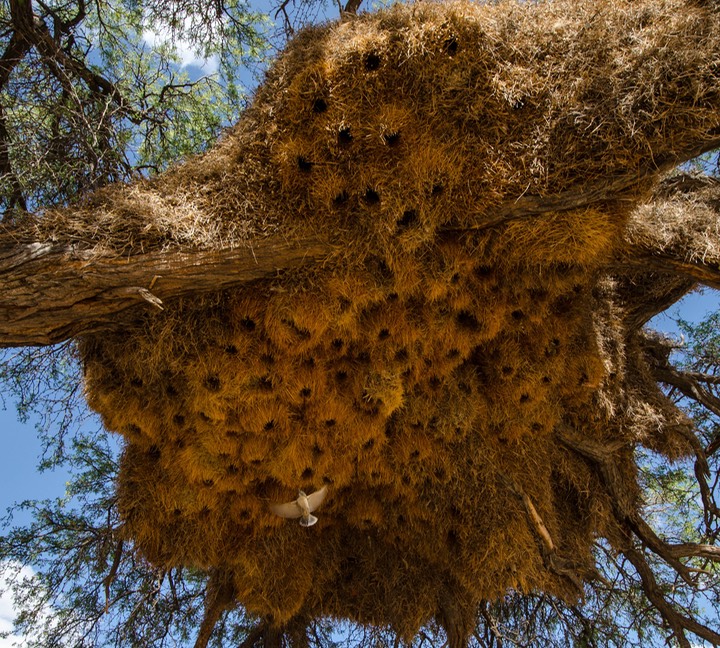
Heading toward Aus, our actual destination was just west of there, at the Klein-Aus Vista Lodge and campsite. What a great spot this turned out to be! Up on a hillside, we had views over the valley, a private site all to ourselves surrounded by rocky hills, semi-wild horses wandering through the camping area, hiking trails to enjoy, a shady spot with breezes, and… a large tree filled with a huge gathering of Sociable Weavers, all for us to ourselves — our very own colony of friendly little birds.
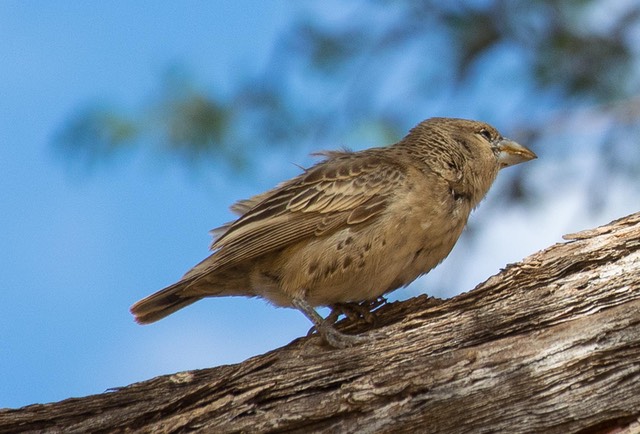
You may remember the Weaver birds we saw in a couple of places in South Africa. These are those birds that hang from a slender branch or two while they build a round nest that looks like a ball; they climb in from the bottom? Well, think of one of those nests as part of a multi-story condominium project, all clumped together in a single construct and supported by a tree limb — such a huge “multi-nest” that sometimes that limb just cannot handle it and comes tumbling down to the ground! That’s what we saw for the first time at this campsite. We have since seen bunches of them, all over the countryside. Pretty wild, and utterly fascinating. The small birds are indeed very sociable and were great company.
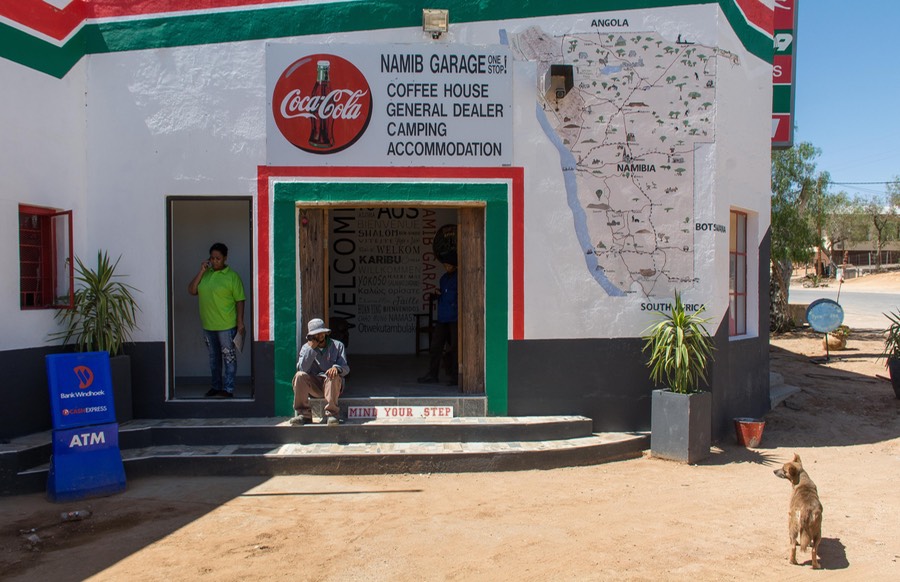
We finally left because we were running low on food, and also needed internet. We pulled into Aus, hoping for good shopping. Well, not really. We scored some things at the Puma fuel station, and more at a little shop further on up the hill. We can manage for several days on that. We also found a lovely piece of batik cloth in the curio store attached to the Puma station. And we did find internet in town. That was good.
From Aus we headed out onto gravel, and started a long wide sweep north through the Tiras Mountains, much of which is a conservancy. This is really splendid country. Beautiful, dramatic vistas, wide open desert. For the time being the road is quite good, and we’re very happy. We had reluctantly decided to make a reservation for a night at Sesriem, the very famous area in the Namib dunes that lie to the northwest of here, and so had started moving in that direction. But we had plenty of time so we meandered some, wandering over passes and across valleys, pointing out ostriches, oryx, and the occasional wild horse.
We stopped at or at least took note of the occasional oddity — a castle/fortress, a turn-off to a mine, a vineyard (in this dry area, at least this spot was getting water) as we wandered on. By now the road had turned quite bad, and it was a bit of a struggle to stay happy. But we buggered on.
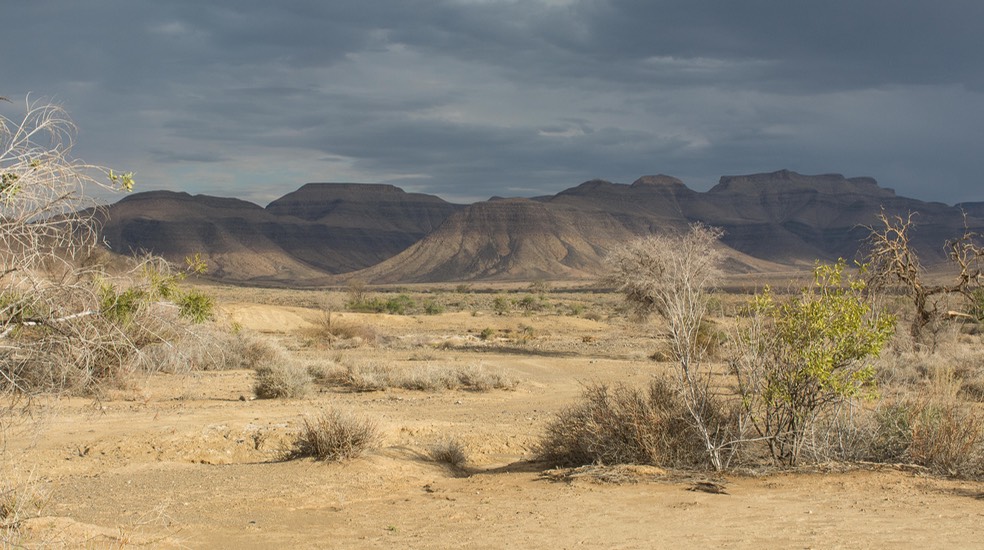
We spent one charming night at a private camping spot along tiny road D854 — the Hauchab Fontein Camping. The German owners were quite nice, agreed with us that the road was quite awful (“the grader is parked down the road a ways — waiting for parts”) and commented on the recent, totally unprecedented rains and sleet. This was the same storm we had experienced during our drive out to the coast. It seems the result here was more rain in one night than the entire previous year — about 62 mm (2-1/2 inches). It had ruined the road (that we knew!), washed out their spring (fontein) and wreaked complete havoc throughout the area. But we had a quiet night in a lovely spot before returning to the road in the morning.
We drove this icky road for several days and clearly the storm had been quite widespread. We also knew it was a bad road anyway; there are many of them in the more rugged parts of Namibia. We’re hoping it will get better in other areas but most likely not. Actually we’ve been told recently that the roads will get worse as we continue further north.
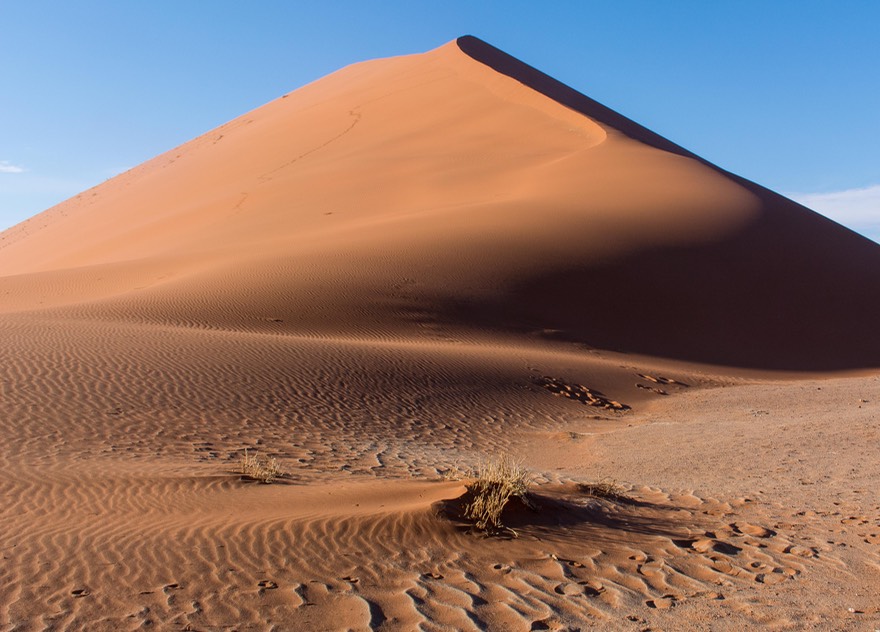
Our ultimate goal was Sesriem and the Sossusvlei area. The dunes there are world-famous, and quite deservedly so. About a year ago we’d seen photos of them in a gallery in Australia, and were quite anxious to get closer. But the information we were getting on how the process works was somewhat confusing. So we just drove up and figured it out as we went along; not surprisingly, it all worked out just fine.
Sesriem, we figured, was a small town. Noop; not even that. It’s just a park headquarters and campsite located in the Namib-Naukluft National Park. It’s on the edge of the dunes everyone is heading toward. So you go there, pay for your permit to explore the dunes (in a very controlled fashion), and then drive (on a nice paved road — amazing!!) the 60 kms out to Sossusvlei, which is the name of the area where the most famous sand dunes are. You cannot camp there; you must camp either at the Sesriem camground, or park at one of the lodges that lurk just outside the gate. Your permit gives you 24 hours to be in the park and enjoy the dunes.
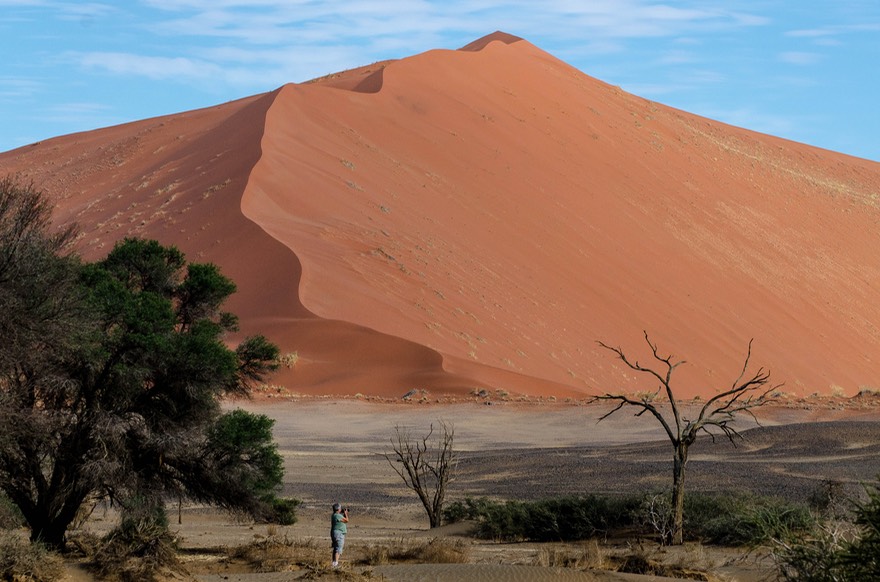
The big issue, however, is that apparently this is the single most visited site in all of Namibia; the crowds can be huge. The attraction is the colors of the sand dunes, which change as the light on them changes. The hot ticket seems to be getting up well before dawn to drive out to the end of the road before sunrise, so you can take a shuttle bus from that parking area out to another spot where you must leave the bus and walk the final kilometer or so to where the “best stuff” is in order to watch the sun come up over that dune and watch it change colors. Along with everyone else.
So how to enjoy it “our way”? By doing what we want to do, not what everyone else is doing, of course. We poked around and enjoyed some of the dunes the afternoon we arrived, hiking up into them a little bit, taking nifty pictures of tracks in the sand left by wandering beetles, enjoying and photographing the dunes in the waning light of late afternoon, and then going back and settling in for the night.
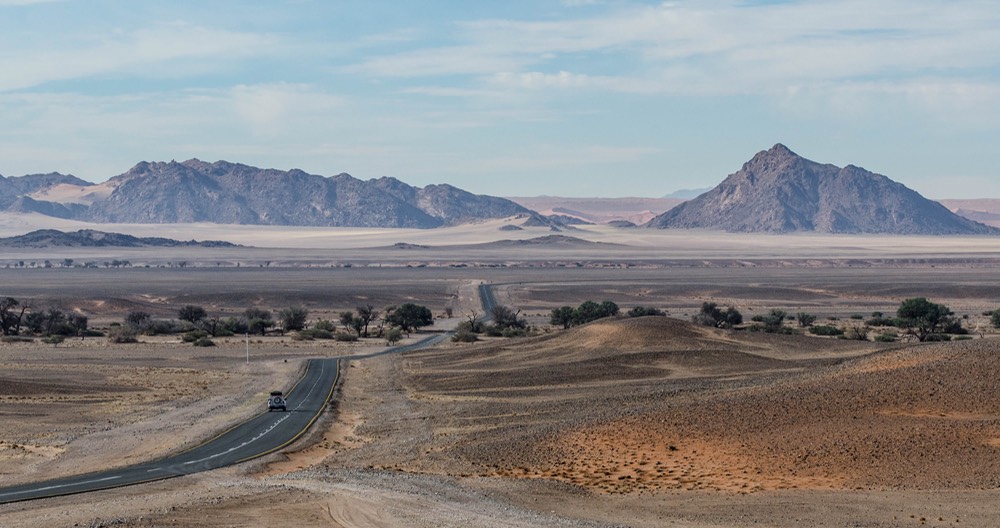
We did get up at about 5:00 the next day, and got ourselves part way down the road toward the “pot of gold”, but the sunrise was sooner than advertised. So we stopped and enjoyed the changing of the colors on the sand dunes right beside where we were. As the morning progressed, we estimate that at least 100 cars (to say nothing of the tour busses) zipped past us on their way out to the parking area at Sossusvlei; what a madhouse!
We ended up spending about three hours messing about in the dunes part way out the road, enjoying the heck out of the experience and almost totally alone, then drove back to the campground and treated ourselves to an excellent breakfast in the restaurant. A very good time was had by all, and we got out of the park with a hour to spare before our 24-hour permit was to expire. Awesome, dudes! Choosing to skip the “must-see” item worked out perfectly for us. Other travelers have mentioned that, on a second visit several years after the first, the whole process was much more commercialized and crowded and less enjoyable; we certainly understand.
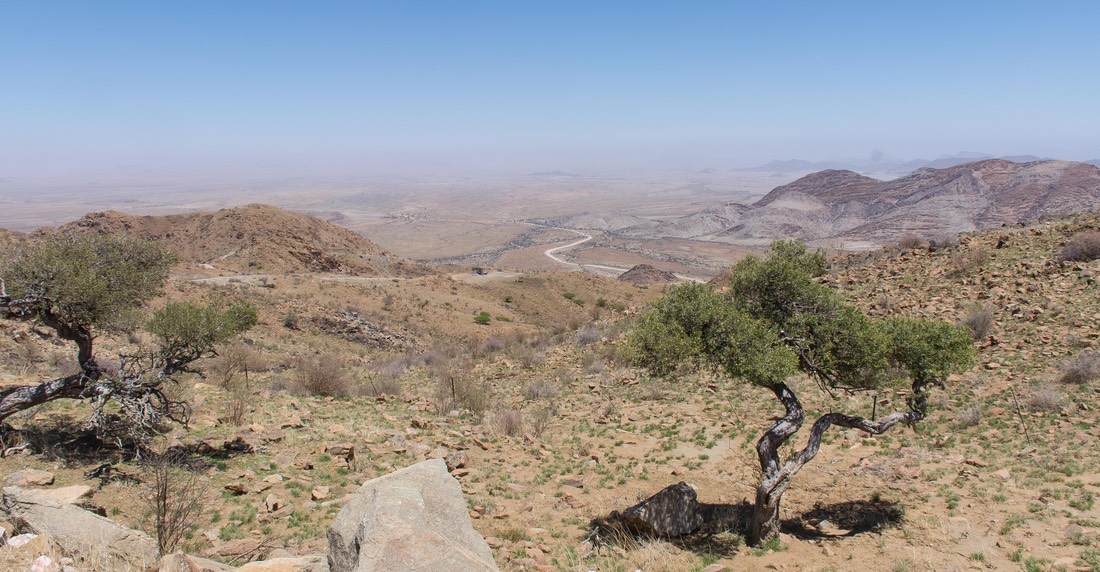
So after you’ve seen the famous sand dunes of Namibia, where do you go? To Solitaire, of course, for the lovely apple crumble at the Solitaire Bakery. It’s not too far up the road, and worth the battering you take along the way from the rough and rocky drive. (Along this road we saw our first Namibian giraffes.) There is no town in Solitaire, by the way, just that bakery, along with a fuel station and tiny lodge/campsite. Don’t forget to fill up, ‘cause it’s a long way to anywhere else.
Internet access had started to become a little bit of an issue and we had some items pending that we wanted to keep working on. The lodge at Solitaire does have internet, but their server didn’t like our computers, and so that was a non-starter. As a result, it was getting to be time to move on out of no-where and head toward civilization, i.e., to Windhoek, the capital.
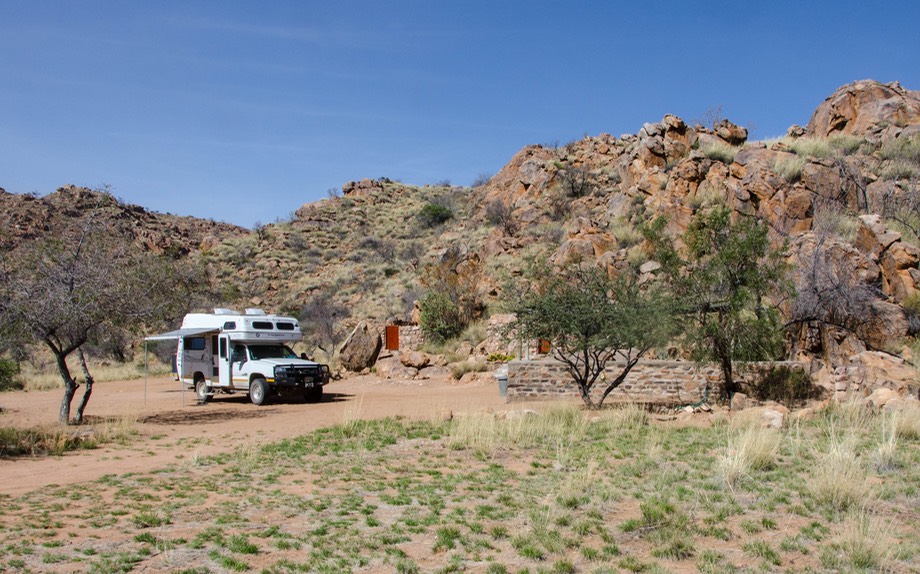
There’s more than one way to get to Windhoek from Solitaire. We took D1275, the winding, steep back road that went over the difficult but dramatic Spreetshoogte pass, through remote and lovely areas, topping off at 1823 meters in windy splendor. Super, just super. A little ways east of the pass we spent some time at Nauams Guest Farm where they raise indigenous goats, along with cattle and other things. We made friends with the family there and promised to return for more time with them if at all possible. This was a really great visit for us, not only for the beauty of the site but for the engaging conversations with our hosts.
Heading on toward the capital, we passed through our first real town in quite awhile, Rehoboth, where we were startled to see lots of trash along the streets and in the fields. Up until now, Namibia had been a welcome change from South Africa, which is pretty trash-filled. Why junky all of a sudden? Maybe the trash company is on strike?
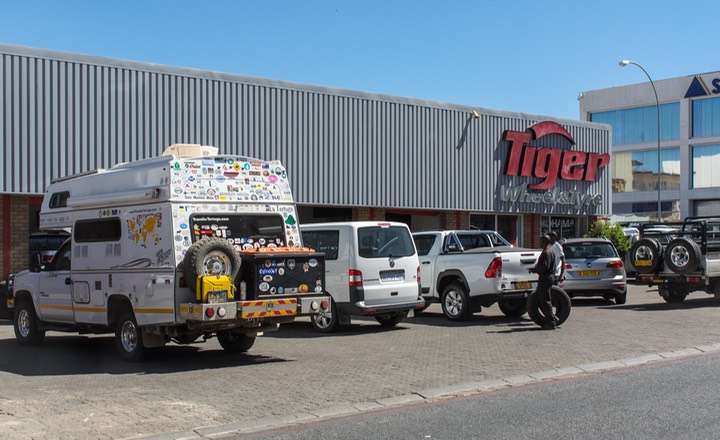
Finally arriving in Windhoek (very clean and tidy), we stayed for several days in the very nice municipal camping site. We filled the larder, got tires rotated (at Tiger Tyres, of course), where La Tortuga was much fussed over, took care of some business, did a lot of computer stuff, and had a city fix. Windhoek is a nice place. (Maybe Rehoboth is just an anomaly.) Not all that big, you can cover the entire downtown area easily and quickly. There are museums, etc. to be enjoyed, but we saved them for another time, as we have made plans to fly home from there in January for a six week visit.
Finishing up our to-do list for Windhoek, and thinking it was getting pretty hot again, we decided to head back out to the coast, by way of some very interesting, somewhat remote areas cutting through the northern part of the Namib-Naukluft National Park. Our ultimate destination was the coastal resort town of Swakopmund and its environs.
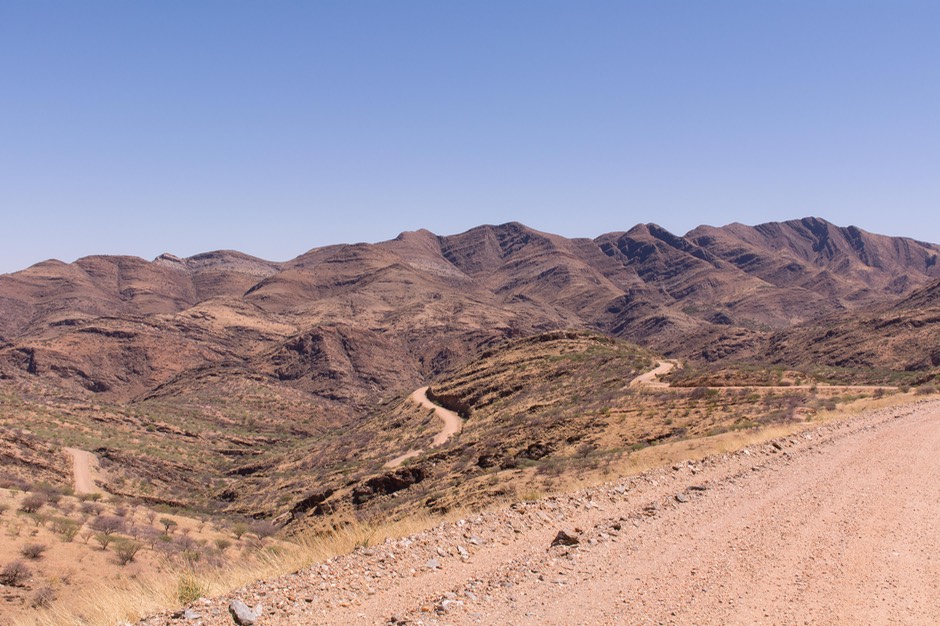
To get there, it seemed there were three possible routes. The easiest and fastest was a paved road (the B2) that was the route “everybody” in Windhoek takes to get to the shore on Friday for their weekend getaway. But there are two smaller, mostly unpaved roads cutting through the park, each with side roads and remote campsites and lots of lonely desert. These through roads were public and could be driven without stopping, but a permit was required in order to wander freely off the main road and to spend several days. Which was our plan. So Rick trudged from office to office to find the right desk (it had been moved since the info was printed) to get the permit. Finally obtained, we headed out of town on a journey that would give us three nights under the desert stars.
We went over Kupfurberg Pass (2072 meters), then Gamsberg Pass (1870 meters), then started our descent down into the desert, heading west on C26. We were in what sophisticated travelers call “Some desolate shit, man!” Oryx dashed across the road in front of us. We followed along dry river beds, with occasional scrawny trees nearby. We spent our first night in a rather nondescript spot, in the partial shade of the only tree around. Okay, but nothing special.
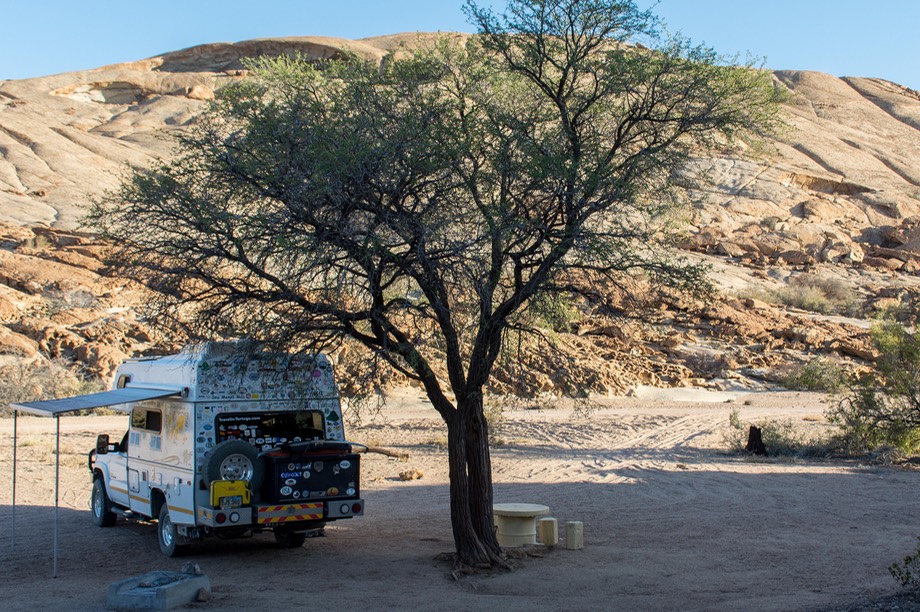
The second day out we went sideways (north, that is) up to the C28, into a different area, and struck paydirt. We found a campsite among boulders and trees in an area tucked back into a (rather) sandy cul-de-sac. It was marked 4x4 only, and for good reason. Rick did just fine in the sand, in part thanks to some good training he’d gotten a couple of years back at an Overland Expo. Tires properly deflated, firm hand on the wheel, lo range, steady pace, all that good stuff. Named the Blutkopje camp site, because the rocks look quite lovely at sunset, we were delighted. We stayed two nights, enjoying cool night and warm/shady days, exploring the rocks and their interesting holes caused by wind-blown sand. Nice spot.
Ultimately our permit expired and we moved on over to the coast. But not without one final adventure. Shortly after getting going on this nasty little road we were enjoying, we went over a bump and heard a thump. Didn’t register for a short distance, but then we stopped to check. The black tank had separated itself from the truck and was laying there in the middle of the road behind us. Again!
Merde! @&#*%!!! Drat! Pulling of Hair, Reddening of Face and Stamping of Feet ensue!!
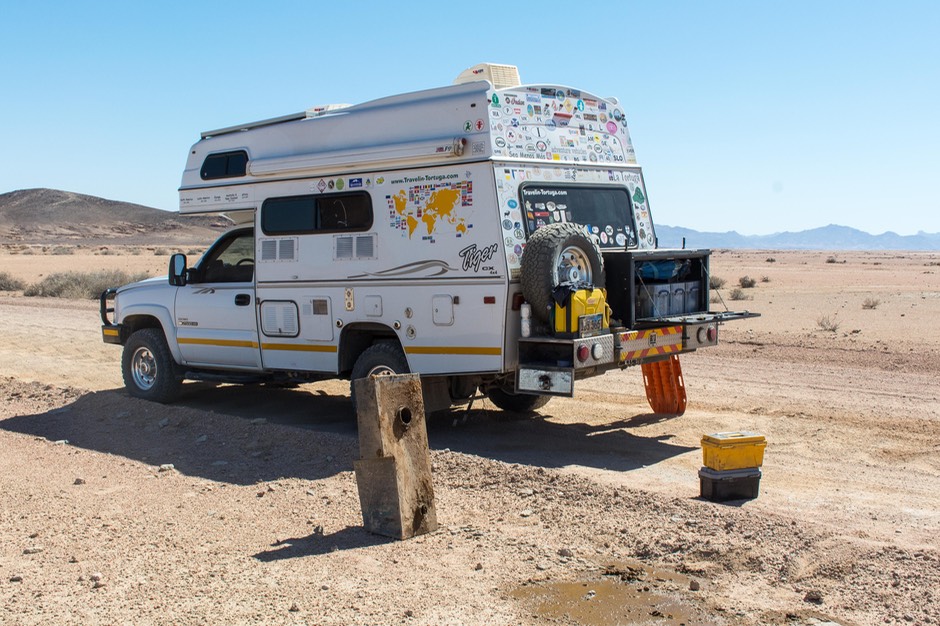
Nothing to be done but to pick up the pieces, strap them to the back of the truck, and limp on down the road. We’d already made an appointment to have the truck serviced in Swakopmund, Rick had the grille off for repairs, and the hood release cable was unhappy; now there would be more work to do. We spent the day moving a little more slowly than usual, arriving in town on a quiet Sunday afternoon, only slightly sheepish.
The next day we started the process of finding folks to help us solve our problems. We were staying in a municipal campground just north of Swakop (local lingo), just up the coast a bit. Without our black tank our toilet was dysfunctional, so we needed facilities — and a fairly quick solution!
Well, as we have said before, if nothing ever went wrong we wouldn’t have good stories to tell and we wouldn’t meet as many interesting people. So it was this time as well. As an aside, Rick checked his records and discovered that Namibia is actually the twentieth country outside the US where we have had the Tiger serviced or repaired — see list below. Wow, that surprised us both. Anyway, as it always has before, once again it all worked out just fine. To borrow from the movie, Shakespeare in Love, how does it all work out, you ask? We don’t know, it’s a mystery.
The shop where we were to have the service work attended to (Mid-Vaal Diesel & Turbo), but who couldn’t repair the black tank, referred us to someone else who in turn referred us to Jacques at Crazy Gecko Accessories and Fitment and they took excellent care of our damaged tank, plastic welding and poly coating the problem areas and then refitting it all with strengthened mounts and new plumbing bits to reconnect the system properly. In two days time we were all set and ready to roll once again. We could not have been more pleased with everyone we dealt with. Swakop Rules!
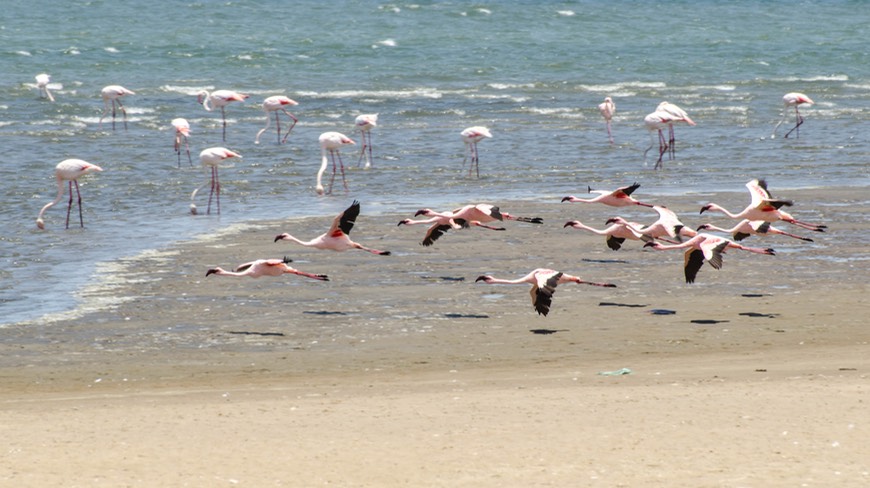
While we sorted it all, we puttered around this small coastal resort area. Walvis Bay provided us with some excellent flamingo pictures, while Swakopmund introduced us to fine fish and chips from a van down on the Strand. The towns themselves are pretty routine, the architecture a tad cookie-cutter, but both quite pleasant. We are currently parked in a simple but nice campground along the water, part way between the two towns, while we prepare for the next phase of our Namibian Campaign. Our intention is to head back inland, into the Spitzkoppe and Erongoberg area, thence to Omaruru, Otjiwarongo, and (finally!) Etosha National Park.
We are surviving quite well it seems. Oh, hold on, La Tortuga adds, “Easy for you guys to say!”
Safe travels from all of us.
Go to the Photo Page to see more pictures of Southern Namibia
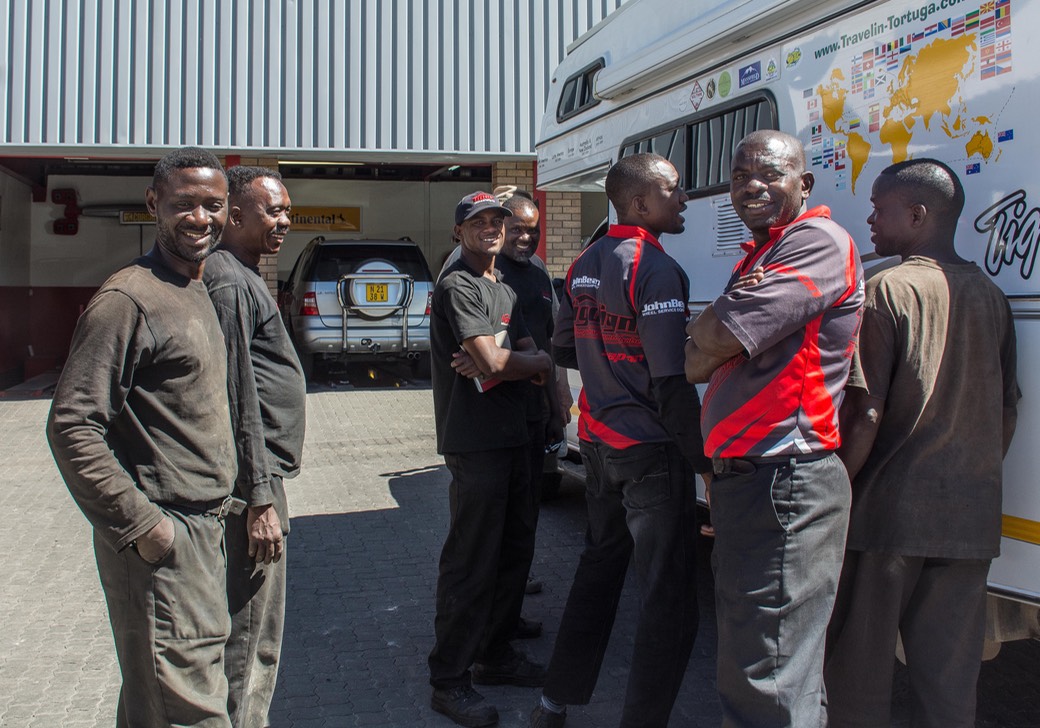
List of countries outside the US where our Tiger has been serviced.
(In chronological order)
Canada, Guatamala, Costa Rica, Colombia, Ecuador, Peru, Chile, England, Ireland, Morocco, Bulgaria, Turkey, Georgia, Armenia, Italy, Scotland, Holland, Australia, South Africa, Namibia